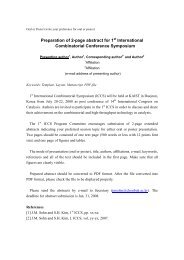Bidding - the International Association of the Catalysis Societies
Bidding - the International Association of the Catalysis Societies
Bidding - the International Association of the Catalysis Societies
You also want an ePaper? Increase the reach of your titles
YUMPU automatically turns print PDFs into web optimized ePapers that Google loves.
1) History<br />
<strong>Catalysis</strong> research in Korea is a relatively young discipline. The first research in<br />
catalysis began when Pr<strong>of</strong>essor Hakze Chon, with a Ph.D. degree from Pr<strong>of</strong>essor<br />
Schwab’s laboratory in München, and 15 years <strong>of</strong> research at Mobil Research<br />
Laboratories in America, returned to Korea to occupy <strong>the</strong> first chair in catalysis at <strong>the</strong><br />
newly created Korea Advanced Institute <strong>of</strong> Science. In March <strong>of</strong> 1979, 15 researchers in<br />
universities and government-funded research institutes got toge<strong>the</strong>r to organize a “club”<br />
to exchange ideas on <strong>the</strong>ir research results. In 1980, a few <strong>of</strong> <strong>the</strong>m attended <strong>the</strong> 7 th ICC<br />
held in Tokyo, Japan. A number <strong>of</strong> prominent scholars attending <strong>the</strong> Congress were<br />
invited to visit Korea and meet with <strong>the</strong> members <strong>of</strong> <strong>the</strong> “club” for <strong>the</strong> first ever<br />
international symposium on catalysis held in Korea. The invited scholars included<br />
Pr<strong>of</strong>essors Schwab, Boudart, Hightower, Kwan, Barthomeuf, Gates and Vannice.<br />
Although <strong>the</strong>re were only about 60 participants altoge<strong>the</strong>r in this first symposium, this<br />
was <strong>the</strong> beginning <strong>of</strong> very rapidly growing activities in catalysis. Most <strong>of</strong> <strong>the</strong> early<br />
pioneers had received <strong>the</strong>ir training overseas and returned to Korea. Major universities<br />
in Korea were training future catalysis researchers and a number <strong>of</strong> government-funded<br />
research institutes were beginning to support catalysis research. In addition to <strong>the</strong><br />
rapidly increasing pool <strong>of</strong> young researchers inside Korea, <strong>the</strong>re were several dozen<br />
Korean students, mostly in <strong>the</strong> U.S., pursuing Ph.D. degrees in catalysis. By 1985, <strong>the</strong><br />
“club” grew enough to be recognized as a major Division within <strong>the</strong> Korean Institute <strong>of</strong><br />
Chemical Engineers (KIChE), one <strong>of</strong> <strong>the</strong> large (5,200 membership) and active<br />
pr<strong>of</strong>essional societies in Korea. Although <strong>the</strong> Division belonged to <strong>the</strong> KIChE, it<br />
accommodated all members <strong>of</strong> <strong>the</strong> Korean Chemical Society and <strong>the</strong> Korean Society <strong>of</strong><br />
Industrial and Engineering Chemistry, who were working on catalysis. Such<br />
membership established a unique character <strong>of</strong> <strong>the</strong> Division, represented by vibrant<br />
discussions and cooperation among scholars in sectors spanning from science to<br />
engineering and from academia to industry. Pr<strong>of</strong>essor Hakze Chon became <strong>the</strong> first<br />
Division director. <strong>Catalysis</strong> was engaged in mostly by those trained in <strong>the</strong> U.S., and<br />
since catalysis is based largely in <strong>the</strong> chemical engineering departments in <strong>the</strong> American<br />
universities, it has come to be associated with <strong>the</strong> chemical engineering pr<strong>of</strong>ession in<br />
Korea also.<br />
Since it was organized as a division in 1984, <strong>the</strong> <strong>Catalysis</strong> Division has grown into <strong>the</strong><br />
most active group within KIChE and, by 1990, <strong>the</strong>y accounted for about 20 % <strong>of</strong> <strong>the</strong><br />
approximately 700 papers presented at <strong>the</strong> two national meetings. As an indication <strong>of</strong><br />
<strong>the</strong> prominence <strong>of</strong> this Division, one division director (Pr<strong>of</strong>essor Hakze Chon) went on<br />
to become a cabinet member as Minister <strong>of</strong> Science & Technology, and four Division<br />
directors served as <strong>the</strong> president <strong>of</strong> <strong>the</strong> Institute since <strong>the</strong> Division was organized 20<br />
years ago. Some <strong>of</strong> <strong>the</strong> activities <strong>of</strong> <strong>the</strong> <strong>Catalysis</strong> Division are:<br />
• Publication <strong>of</strong> <strong>the</strong> bi-annual journal “<strong>Catalysis</strong>” since 1985<br />
• Organized 3-day annual summer research conferences modeled after Gordon<br />
Conference since 1988, <strong>the</strong> 2003 conference drawing over 80 active participants<br />
• Organized industrial catalytic technology workshops at <strong>the</strong> two major<br />
petrochemical complexes since 1992<br />
- 59 -



